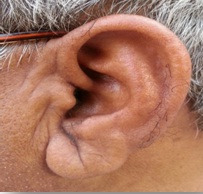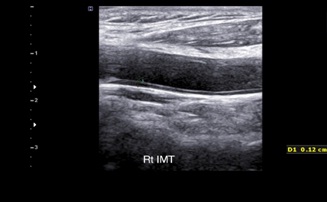
Frank’s Sign: An Indicator for Premature Aging?
*Corresponding Author(s):
Vismay NaikDepartment Of Medicine, BAPS Yogiji Maharaj Hospital, Gujarat, India
Tel:+91 9909929795,
Email:vismay101@gmail.com
CASE REPORT
Frank’s sign (diagonal ear lobe crease) is a dermatological marker on the ear which extends from the tragus to the rear edge of the auricle. A positive correlation of Frank’s sign with atherosclerosis and coronary artery disease is well known [1]. Recently, it has been shown to be associated with premature aging and loss of dermal and vascular elastic fibres [2]. Various studies have also shown an increase in the carotid Intimal Medial Thickness (IMT) and loss of carotid artery elasticity, with increasing age [3,4]. Raised carotid IMT for age indicates increased vascular age and premature aging [4].
We present a case of a patient, free of any clinical cardiovascular symptoms, who had Frank’s sign on examination and was found to have increased carotid IMT for his age, suggesting premature vascular aging and indicating the association of Frank’s sign to early aging.
A 50-year-old Asian Indian man came to the hospital for a routine health check-up. He was asymptomatic with only complain of occasional episodes of dizziness and “black outs”. Patient denied any complaints of chest pain or shortness of breath at rest or on exertion. He was a tobacco chewer for the past 20 years with no significant past medical or family history of cardiovascular disease. On physical examination the patient was found to have bilateral diagonal earlobe creases as shown in figure 1. His blood pressure was 130/80 mmHg. His blood investigations showed hypercholesterolemia with an LDL of 180 mg/dl. His electrocardiogram was normal. Bilateral Carotid artery B mode ultrasonography showed an IMT of 1.2 mm in the right common carotid artery (Figure 2), the normal carotid IMT for his age being 0.56 mm to 0.71 mm [3]. This clearly suggested the patient was having increased vascular age (that of >70 years) and supports the correlation of Frank’s sign with premature aging and loss of dermal and vascular elastic fibres. The patient was at increased risk for adverse cardiovascular events and was started on Aspirin and Atorvastatin for primary prevention.
Figure 1: Diagonal ear lobe crease.
REFERENCES
- Christoffersen M, Frikke-Schmidt R, Schnohr P, Jensen GB, Nordestgaard BG et al. (2014) Visible age-related signs and risk of ischemic heart disease in the general population: a prospective cohort study. Circulation 129: 990-998.
- Griffing G (2014) Images in clinical medicine. Frank’s sign. N Engl J Med 370: 15.
- Lim TK, Lim E, Dwivedi G, Kooner J, Senior R (2008) Normal value of carotid intima-media thickness--a surrogate marker of atherosclerosis: quantitative assessment by B-mode carotid ultrasound. J Am Soc Echocardiogr 21: 112-116.
- Juonala M, Kähönen M, Laitinen T, Hutri-Kähönen N, Jokinen E, et al. (2008) Effect of age and sex on carotid intima-media thickness, elasticity and brachial endothelial function in healthy adults: the cardiovascular risk in Young Finns Study. Eur Heart J 29: 1198-1206.
Citation: Vismay Naik (2015) Frank’s Sign: An Indicator for Premature Aging? J Clin Stud Med Case Rep 2: 015.
Copyright: © 2015 Vismay Naik, et al. This is an open-access article distributed under the terms of the Creative Commons Attribution License, which permits unrestricted use, distribution, and reproduction in any medium, provided the original author and source are credited.

